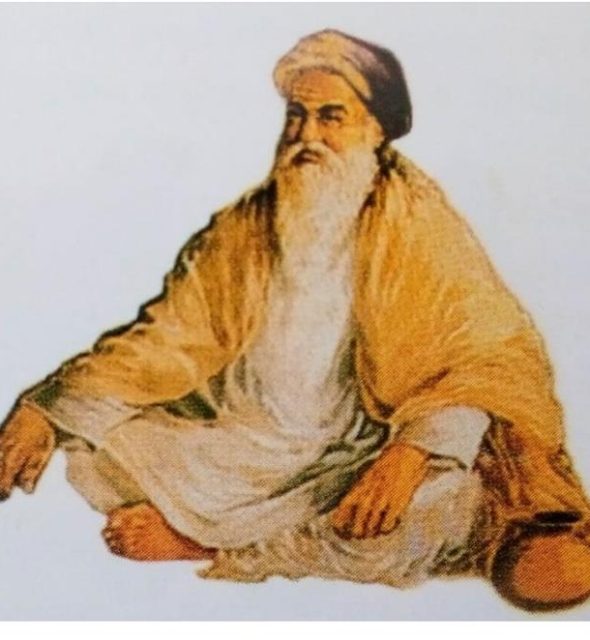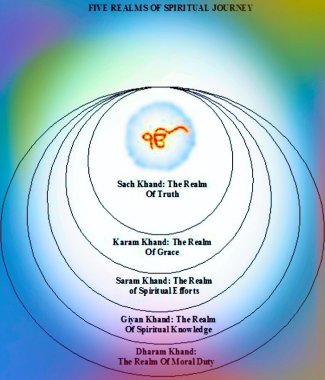BUR MAJRA, a small village about 8 km east of Chamkaur Sahib (30°53`N, 76°25`E) in Ropar district of the Punjab, claims a historical shrine, Gurdwara Patshahi 10 located near an old well. It is said that Guru Gobind Singh, while proceeding to Chamkaur on 6 December 1705 after evacuating Anandpur Sahib, halted here awhile. The well which has existed since then provided water for the trav ellers and their horses. The Gurdwara commemorating the visit, comprises a divan hall with the sanctum for the Guru Granth Sahib in the centre. The management is in the hands of the Nihangs.

BHAGAT- Bhagat has roots in the word Bhaj or Bhakt, which means divided (into self and the \'other\'; this \'other\' may be a god or the Almighty) or sacrificed (into pieces for some god or for the Almighty); hence, Bhagat is one who is devoted to some god or the Almighty. The word Bhagt has also been traced to the word Bhaj (to adore, honour, love, revere etc.). It has another root: Bhagvata (devotee of Bhagwan). According to Sikhism, a Bhagat is one who is devoted to the Almighty.
CHAKK FATEH SINGHVALA. 3 km south of Bhuchcho Mandi (30° 13`N, 75° 5`E) in Bathinda district of the Punjab, and one of the cluster of villages known as Bhai ke Chakk because of the association of the family of Bhai Bhagatu with them, was visited by Guru Gobind Singh, on his way from Talvandi Sabo to Bathinda. ISJeth 1763 Bk / 16 May 1706 is preserved in local tradition as the date of Guru Gobind Singh`s arrival in the village where he put up for a week. The main shrine, Gurdwara Sri Guru Gobind Singh Ji Sahib, a 4metre square domed sanctum on a high plinth, is on the eastern outskirts of the village, with a small sarovar or holy tank in the vicinity.
DALLA, BHAI (later Dall Singh), a Siddhu Jatt and chaudhari or landlord of Talvandi Sabo, enthusiastically received Guru Gobind Singh when he arrived there with his entourage early in 1706, and attended diligently to the needs and comforts of the daily growing sangat. According to Bhai Santokh Singh, Sn Gur Pratap Suraj Granth, Dalla maintained a private army of several hundred warriors of whom he was very proud. He more than once commiserated with Guru Gobind Singh on the events that had overtaken him, boastfully adding that had the Guru called him for help he would have joined him with his bold warriors and that he (the Guru) would have been saved much of the travail. Guru Gobind Singh every time dismissed the topic saying, "God`s will must prevail. It is useless to brood over the past. "
DAYA SINGH, BHAI (1661-1708), one of the Panj Piare or the Five Beloved celebrated in the Sikh tradition, was the son of Bhai Suddha, a Sobti Khatri of Lahore, and Mai Diali. His original name was Daya Ram. Bhai Suddha was a devout Sikh of Guru Tegh Bahadur and had visited Anandpur more than once to seek his blessing. In 1677, he travelled to Anandpur along with his family including his young son, Daya Ram, to make obeisance to Guru Gobind Singh, this time to settle there permanently. Daya Ram, already well versed in Punjabi and Persian, engaged himself in the study of classics and gurbani. He also received training in the use of weapons.
DUSANJH KHURD, village 3 km south of Banga (31° ll`N, 76°E) in Jalandhar district of the Punjab, has a historical shrine called Gurdwara Guru Har Rai Sahib Patshahi Satviri (seventh) dedicated to the Seventh Guru, Guru Har Rai. In 1940, the local sangat raised a new building on the site of the older shrine. The Guru Granth Sahib is seated on a high dais in the centre of the central hall, to which another hall was added later. Residential quarters and Guru ka Langar are on the left of the main building. The Gurdwara is affiliated to the Shiromani Gurdwara Parbandhak Committee.
DIWAN KHANA GURUDWARA, LAHORE:This Gurdwara is situated near Chuni Mandi chowk, close to the birth place of Guru Ram Das ji. The Guru\'s ancestors belonged to Lahore. At the time of the marriage of one the sons his elder brother, Sahari Mal, the Guru asked his son (Guru) Arjan Dev to attend the cere money, as he himself was unable to attend the same.

FIVE KHANDS or Panj Khands, lit. realms (panj == five, khand == region or realm), signifies in the Sikh tradition the five stages of spiritual progress leading man to the Ultimate Truth. The supporting text is a fragment from Guru Nanak`s Japu, stanzas 34 to 37. The Five Realms enumerated therein are dharam khand, the realm of righteous action (pauri 34), gian khand, the realm of knowledge (pauri 35), saram khand, the realm of spiritual endeavour (pauri 36), karam khand, the realm of grace, and sach khand the realm of Truth (pauri 37).






